Abstract
A large set of undrained compression triaxial tests was carried out on different types of cohesionless soils, from sands to silty sands and silts. Shear wave velocity measurements were also carried out. These tests exhibit distinct state transitions ranging from flow liquefaction to strain softening or strain hardening. With the purpose of defining a framework to assess soil liquefaction, it was found that the ratio between the shear wave velocity (VS0) and the peak undrained deviatoric stress (qpeak), VS0/qpeak, could be accurately used to define a boundary between liquefaction and strain hardening for sands and between strain softening and strain hardening for silty sands and silts. Since this ratio is a function of the tested material, the prediction of these boundaries can be made as a function of soil grading, namely via the coefficient of uniformity, CU. Despite not being regarded as a strong geomechanical parameter, CU is easily determined from a grain-size distribution test and has an empirically proven correlation with critical state parameters.
1. Introduction
Static liquefaction has been identified in several tailings dam failures [1,2,3] where loose saturated soils are deposited. These accidents resulted in severe consequences in terms of casualties, damages, environmental impacts and serious disruptions in the raw materials supply. The increasing number of these accidents has prompted more research in this area aimed at enhancing the design of these geotechnical structures and contributing to their sustainable construction and exploration. A large number of these facilities are immobilized and have to be removed (decommissioned) due to the high levels of failure probability. This condition demands for particularly sensitive deconstruction techniques that require a very accurate knowledge of the consequences of the necessary interventions on these highly unstable materials.
The assessment of soil liquefaction potential using laboratory techniques was initiated by Casagrande in 1936 [4], who proposed the critical void ratio line (CVR), nowadays known as the critical state line (CSL), as a boundary separating liquefiable from non-liquefiable soils. Later, Been and Jefferies (1985) [5] proposed the state parameter, ψ, assuming the existence of a unique CSL. This parameter is usually correlated, for static liquefaction assessment purposes, with the brittleness index, IB, which measures the normalized degree of strain softening of a contractive soil using the peak and minimum shear strengths, σ′d(peak) and σ′d(min), respectively (e.g., [6,7,8]). Despite being widely consistent, both parameters are dependent on the soil type. Moreover, the state parameter also requires the previous laboratory determination of the position of the CSL. Nevertheless, in order to provide a universal framework, ref. [7] after [9], proposed the normalization of the state parameter as a ratio between ψ and the slope of the CSL, λ (ψ/λ).
Shear wave velocities were also used to assess soil liquefaction potential (especially cyclic liquefaction), which was initiated by Stokoe et al. (1988) [10] and later adapted by [11] through the correlation of the normalized small-strain shear wave velocity with the cyclic resistance ratio, CRR.
In the case of static liquefaction, the combination of both strength and stiffness measurements, using the seismic cone penetrometer test (SCPTU), for example, was found to effectively predict liquefaction response as it has a good correlation with the state parameter [12,13,14]. This combination also has the advantage of distinguishing between recent and/or aged or cemented deposits [15]. Its successful combination was already somewhat expected as both variables are controlled by the confining stress, void ratio, stress history, soil structure and geological age [16,17,18] and are also correlated with critical state parameters, which governs soil liquefaction response.
Schnaid et al. (2013) [19] used triaxial compression and extension tests with bender elements to develop a framework for the assessment of static liquefaction on gold tailings, showing that peak undrained deviatoric stress and shear wave velocity are correlated.
More recently, Riveros and Sadrekarimi (2021) [20] used the normalized shear wave velocity to distinguish between liquefiable and non-liquefiable soils, proposing an empirical method to evaluate the onset of instability and the post-liquefaction strength of tailings using shear wave velocity. However, it is assumed that this relationship is still soil-dependent, as demonstrated by [21]. Doygun et al. (2019) [22] shows that shear wave velocity in granular soils is significantly affected by the uniformity coefficient and fines content, which affect liquefaction potential [23]. Moreover, Santamarina and Cho (2004) [24] and Cho et al. (2006) [25] demonstrated that particle size and shape can be correlated with different critical state parameters as the macro scale behavior of the soil results from particle-level interactions.
This study aims to evaluate the applicability of the correlations between peak undrained deviatoric stress and shear wave velocity to assess the static liquefaction potential in different soils. The aim is to discuss its range of application and limitations depending on particle size, based on experimental evidence. This is very important to expand the methodologies for liquefaction assessment.
2. Material Properties
During this research, five materials were studied: (1) Osorio sand, a uniformly graded sand from Brazil, well-documented in past research (e.g., [26,27]); (2) a silt, artificially produced from grinding Osorio sand; (3) a silty sand (designated as “mixture”), artificially produced by mixing soils 1 and 2; (4) Algeria sand and (5) Coimbra sand, two uniformly graded sands, also well-documented in the literature (e.g., [28,29,30,31]).
The results obtained for these materials were presented and compared with the study previously published by [19] on gold tailings.
Table 1 summarizes the main gradation characteristics of these materials, including the fines content (FC), the coefficients of uniformity and shape, CU and CC, and the specific gravity. The fines are non-plastic as the fine fraction is silt and not clay. The maximum and minimum void ratios are also presented for the three sands, but not for the finer materials as the standards of these tests (for instance, [32]) are not applicable to soils with high fines content.

Table 1.
Gradation characteristics of the materials.
2.1. Gold Tailings
The particle size distribution of the gold tailings (Figure 1), determined at the Geotechnical Laboratory of FEUP (LabGeo), reveals a well-graded soil classified as a silt with sand according to the Unified Soil Classification System [33]. The specific gravity, Gs, also determined at LabGeo, is 2.94. The grains are generally sub-angular and angular with uneven edges, as shown in Figure 2.
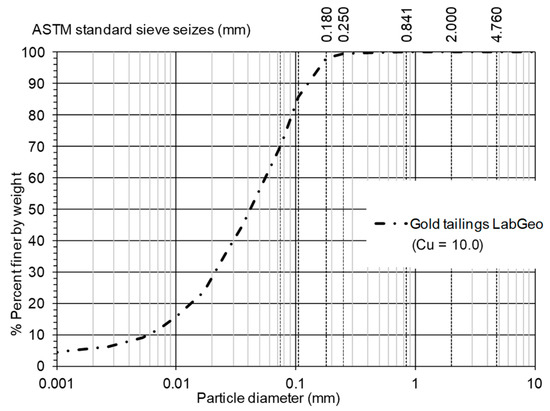
Figure 1.
Grading curve and coefficient of uniformity of gold tailings determined at LabGeo [34].
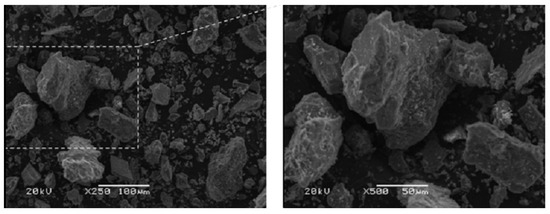
Figure 2.
Grain shape of gold tailings—microstructural analysis [35].
2.2. Osorio Sand
Osorio sand is a siliceous fine sand from the region of Osorio near Porto Alegre in southern Brazil, with a specific gravity of 2.65 [26]. This soil is classified as a non-plastic uniform fine sand according to the Unified Soil Classification System [33]. Grain size distribution results are provided in Figure 3a (dashed line) and evidence a material with a minimum amount of fines (<4%).
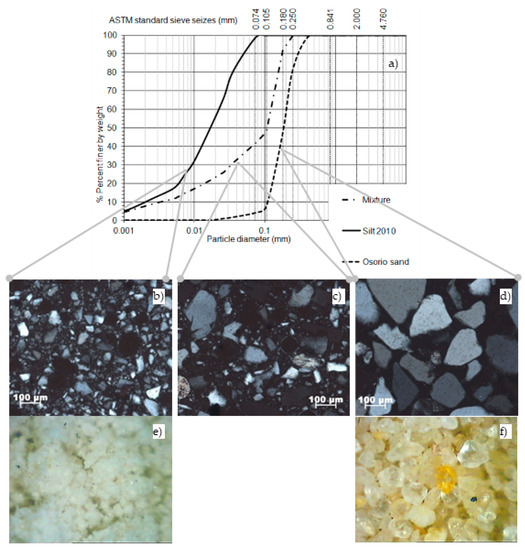
Figure 3.
Comparison of the grading curves of the silt, Osorio sand and the mixture (all of them determined at LabGeo at FEUP) [34] (a) with the images of the corresponding grains: (b,e) for the silt, (c) for the mixture, and (d,f) for Osorio sand.
The coefficients of uniformity and curvature of CU = 1.9 and CC = 1.0, respectively, characterize this as a uniformly graded sand (Figure 3a, dashed line). Microscopic analysis of particle shape enabled the identification of generally rounded to sub-rounded grains, with a few sub-angular grains, as previously reported by other authors (e.g., [26]) (Figure 3d,f).
2.3. Silt
The silt is obtained from grinding Osorio sand, being a siliceous silt with a minor amount of sand (99.85% silt; <1% sand), as shown in Figure 3a (solid line). The coefficients of uniformity and curvature of this soil are CU = 9.6 and CC = 1.47, respectively, revealing a well-graded silt.
2.4. Mixture
The mixture of the two previous materials results in a silty sand (60% sand; 40% silt), which has also been independently studied. This material was produced with the purpose of obtaining a material with an intermediate particle size distribution between Osorio sand and silt. Its specific gravity of 2.65 is necessarily identical to that of the original sand and silt. The coefficients of uniformity and curvature, CU = 32.4 and CC = 2.6, indicate a well-graded silty sand according to the Unified Soil Classification System [33]. From the observation of microscopic photographs, the grains are classified as generally sub-angular to angular with uneven edges, created by the grinding process (Figure 3c).
2.5. Algeria Sand
Algeria sand is a siliceous medium sand, with coefficients of uniformity and curvature of 1.76 and 0.97, revealing a poorly graded sand according to the Unified Soil Classification System [33] (Figure 4). Algeria sand is predominantly quartz sand with a minimal amount of feldspars. As shown in Figure 5, the grains are generally relatively spherical.
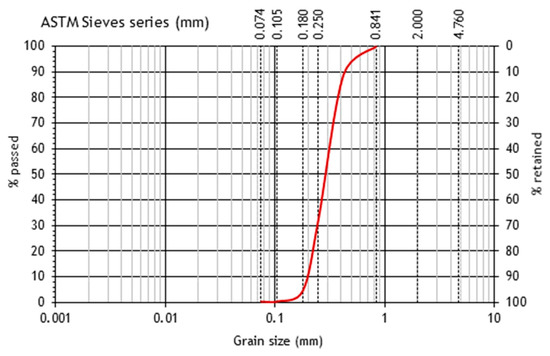
Figure 4.
Grading curve and coefficient of uniformity of Algeria sand.
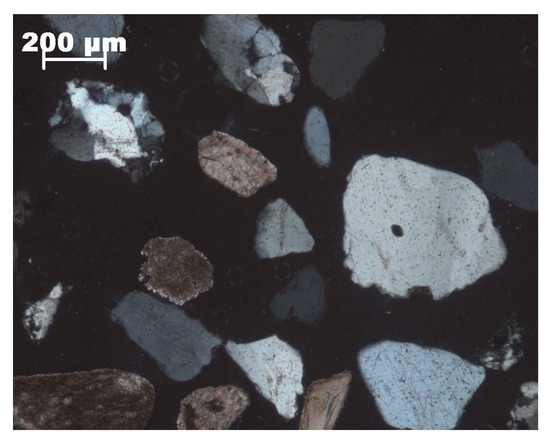
Figure 5.
Grain shape of Algeria sand [31].
2.6. Coimbra Sand
Coimbra sand is a predominantly siliceous sand, artificially prepared from a quarry. The coefficients of uniformity and shape are CU = 2.13 and CC= 1.37, respectively, consistent with a poorly graded sand classification according to the Unified Soil Classification System [33] (Figure 6). The minimum and maximum void ratios correspond to emin = 0.48 and emax = 0.81, and the grains are generally sub-angular (Figure 7).
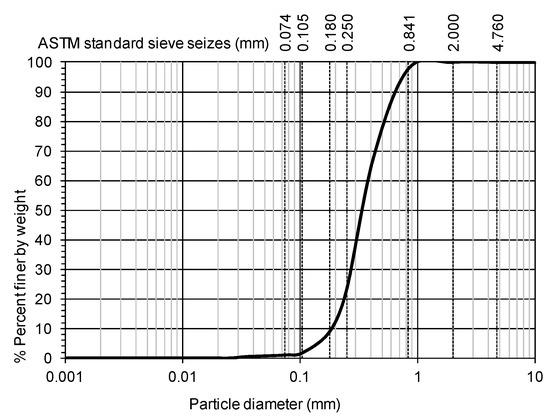
Figure 6.
Grading curve and coefficient of uniformity of Coimbra sand [34].
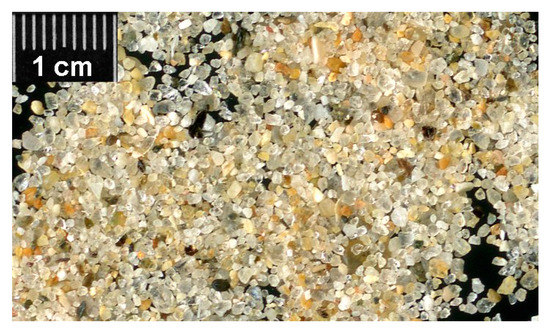
Figure 7.
Grain shape of Coimbra sand.
3. Specimen Preparation and Testing Conditions
The specimens were tested at different void ratios, but usually reconstituted to very loose conditions, and a wide range of confining pressures, aiming to evaluate their influence on liquefaction susceptibility. The reconstituted specimens were prepared by moist tamping with a water content of 5% for all uniformly graded sands (Osorio, Algeria and Coimbra sand), 11.5% for the silt and gold tailings [35] and 8.75% for the mixture (an intermediate value between 11.5% and 5%). These values were obtained by testing different tamping moisture contents, with the purpose of achieving a high void ratio. The moist tamping procedure was selected since [31] showed that inherent anisotropy created by specimen preparation with moist tamping or funnel dry pluviation did not significantly interfere with the liquefaction susceptibility of Coimbra sand.
It is also an effective, easy and relatively quick reconstitution technique that does not segregate soil particles (as opposed to the dry funnel pluviation technique), allowing the operator to control the final density much more readily [36]. The moist tamping reconstitution technique, used in this research, is described in detail in [37].
A large set of strain and stress-controlled triaxial tests were performed to study the static liquefaction potential of these soils. Thirty-eight undrained isotropically consolidated triaxial compression tests (CIU) are presented and discussed in this paper, together with twelve CIU triaxial tests published by [19]. The results of those tests are presented in Table 2, Table 3, Table 4, Table 5, Table 6 and Table 7, where the test ID indicates the first letter of the soil (G for gold tailings, O for Osorio, S for silt, M for mixture, A for Algeria and C for Coimbra), followed by CU (undrained compression) and test number. Each triaxial test was carried out following the typical stages: percolation, saturation, consolidation and shear. In the initial stage, the specimens were percolated with de-aired water in a volume no less than twice the initial voids volume and saturated by back-pressuring at constant effective stresses prior to undergoing the consolidation and shearing stages. A minimum Skempton’s B parameter of 0.97 was ensured prior to the consolidation stage for most specimens. The specimen saturation was often verified by a P-wave velocity around 1500 m/s, measured by bender–extender elements.

Table 2.
Set of results of CIU compression triaxial tests performed on gold tailings.

Table 3.
Set of results of CIU compression triaxial tests performed on Osorio sand.

Table 4.
Set of results of CIU compression triaxial tests performed on the silt.

Table 5.
Set of results of CIU compression triaxial tests performed on the mixture.

Table 6.
Set of results of CIU compression triaxial tests performed with Algeria sand.

Table 7.
Set of results of CIU compression triaxial tests performed with Coimbra sand.
Volumetric strains were systematically evaluated and recorded using internal/local transducers (inductive hall-effect calipers) to measure axial and radial deformation until the end of the saturation phase and complementarily monitored by a volume change gauge during the consolidation and shear stages. In addition, the tests presented in this paper were carried out on triaxial apparatuses equipped with bender–extender elements (for S- and P-wave velocity measurements) at the pedestal and cap. When excited, the transmitting bender element vibrates in a direction perpendicular to the length of the element producing a shear wave, which is registered in the other bender, located at the other end of the specimen. The shear wave velocity, Vs0, is then calculated from the ratio between the tip-to-tip travelling distance (d) and the travel time (t), based on the first wave arrival method (described in [38]), according to Equation (1):
The shearing stage was applied under both strain-control and stress-control on “Bishop–Wesley” stress-path cells and classical triaxial cells, respectively, up to at least 20% axial strain, until the critical state or “true” liquefaction was reached. The undrained tests were typically sheared with a strain rate of 0.05 mm/min while the ones carried out on the “Bishop–Wesley” cells required an initial stress rate specifically determined to enable shearing during less than one day. Despite the occurrence of bulging or excessive deformation, thus creating a complex distribution of stresses and strains inside the sample, the steady state was often reached for strains lower than 20% due to its “natural” proximity to the critical state line. It should be noted that the steady state line is classically defined under constant pore water pressure and constant shear stress conditions with increasing shear strain. On the other hand, liquefaction onset occurred at a very low shear strain and therefore no bulging or excessive deformation affected the phenomenon.
Membrane penetration tends to underestimate the pore pressure for loose specimens (e > ec) and to overestimate the pore pressure of dense specimens (e < ec). According to [39], this effect should be corrected only if the D20 of the soil is higher than twice the membrane thickness. As none of the tested soils have a D20 higher than 0.8 mm, this effect was considered negligible and therefore not taken into account.
Membrane rigidity may have a restraining effect, mainly for low confining pressures and when barreling occurs, over-predicting soil strength. Both deviator and mean effective stresses were corrected for the membrane effect, according to the European standard [40].
4. Liquefaction Assessment Based on Stiffness/Strength Parameters
4.1. Definition of the Critical State Lines
Following numerous studies published on soil liquefaction assessment (e.g., [6,7,8,41]), it is recognized that the state parameter, , has a significant influence on liquefaction instability. For that purpose, this study initiated with the determination of the steady state line (SSL) for all the distinct soils (SSL is defined as the ultimate state achieved under undrained conditions, whilst CSL is defined as the ultimate state achieved under drained conditions).
Results obtained from both drained and undrained triaxial tests performed with Osorio sand are shown in Figure 8, where there are four different plots, including the stress–strain curves, the q-p′ and the e-log p′ paths followed by each triaxial test, as well as the identification of the SSL and CSL. For simplicity, only the plots associated with this soil are included. Any further reference to the other soils can be found in [34]. Similarly, further details concerning the other triaxial tests, namely non-CIU, are provided in [34]. The tables presented in this paper refer only to CIU triaxial tests.
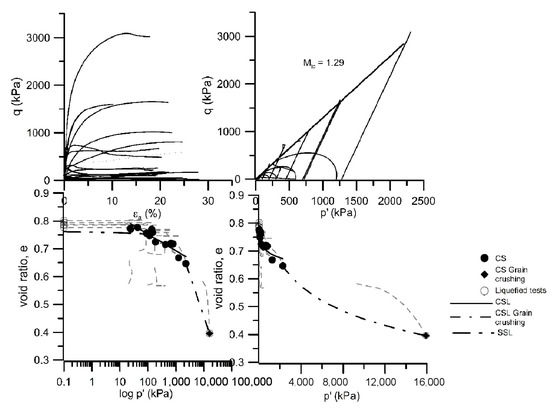
Figure 8.
Critical state and steady states lines of Osorio sand.
However, it was perceived that the state parameter per se could not be used to accurately determine the limit beyond which soils exhibit a stable behavior if it is based on a linear CSL obtained from drained tests at low confining stresses or undrained tests at medium stresses. Figure 9 shows, as an example, the critical and steady state lines obtained for the mixture while Figure 10 summarizes this idea, showing a sketch of the distinct ultimate state conditions.
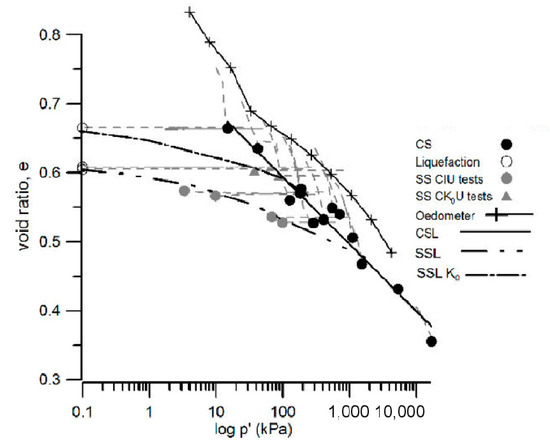
Figure 9.
Critical and steady state lines of the mixture.
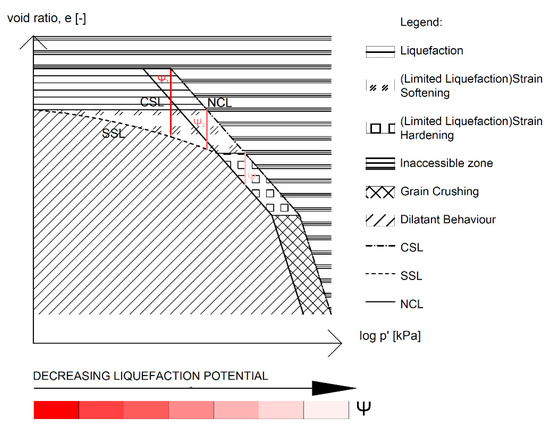
Figure 10.
Normal state line, critical state line and steady state line for sands and silts; undrained shear strength of soils delimited in a diagram e-log p′; measurement of liquefaction potential through the state parameter ψ.
Additionally, the stress ratio at critical state (M = q/p′) was obtained for the different soils and compared to the particle morphology classified in a qualitative way (Table 8). From these results, it is observed that Osorio sand, which has rounded particles, has a lower critical state friction angle (related with ) than the silt, which shows more angular particles due to the grinding of Osorio sand. This is expected as particle angularity improves the interlocking of the particles.

Table 8.
M values compared with soil morphology.
4.2. Definition of the Instability Line
The loci in the p′-q-e space of the onset of liquefaction (identified by the peak undrained deviatoric stress) define the instability line (“IL”), as suggested by [42]. Figure 11 shows the IL for all the soils under study. It is interesting to note the strong correlation coefficient (R2) obtained, despite involving different types of soils with different M values.
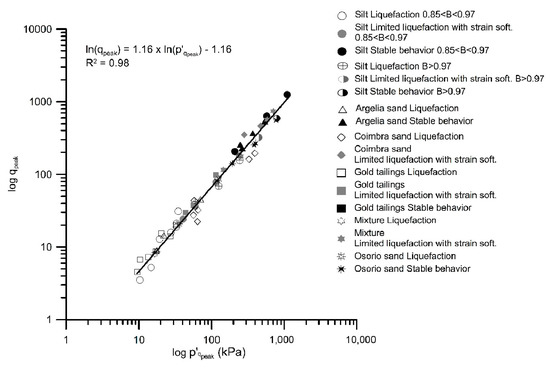
Figure 11.
Instability line of all soils on a log–log scale.
According to some published works (namely [43,44]), the IL is shown to be dependent on the initial confining stress and the initial void ratio (e.g., [45]). However, this effect might be a result of the relative positioning of the initial state of the soil in the p′-q-e space, with reference to the IL. Such a fact could explain the strong correlation observed between the ILs obtained for the six different soils presented in Figure 11.
4.3. Liquefaction Assessment
Whilst the state parameter has the limitations previously mentioned, both stiffness (expressed by the shear wave velocity, Vs0) and the peak undrained deviatoric stress (qpeak = σV − σH) are controlled (although differently) by the void ratio, mean stress state, contractiveness and soil structure. For this reason, these parameters were found to be particularly useful for predicting soil behavior [19].
The peak deviatoric stress occurs before the onset of complete (qult = 0 kPa) or partial (qult > 0 kPa) instability. It should be noted that “complete” or “true” liquefaction is achieved when a null mean effective stress is reached whilst “partial instability” is typically achieved by specimens which exhibit strain hardening and/or strain softening after reaching the phase transformation line and therefore always exhibit an ultimate deviatoric stress. A sketch comparing these distinct behaviors is shown in Figure 10.
VS0 is the shear wave velocity, measured after consolidation and prior to shearing. The respective normalized parameters q1 and VS1 have been defined as follows:
where is the atmospheric pressure (approximately 100 kPa), is the coefficient of earth pressure at rest, is the mean effective confining pressure and is the vertical effective stress.
Figure 12 correlates q1 and the ratio VS0/qpeak for all the studied materials in a single plot, showing that it is possible to define the boundaries between true liquefaction and strain softening for finer materials as well as between true liquefaction and strain hardening for uniformly graded sands. The adopted symbols aim to distinguish true liquefaction (open symbols) from a strain softening behavior (grey symbols) and from a stable behavior, characterized by strain hardening (black symbols). This figure clearly distinguishes the boundaries of soil behavior, which correspond to the ratios for true liquefaction triggering provided in Table 9 for the soils under study. As shown in Figure 12, it is clear that low VS0/qpeak and high q1 correspond to a stable condition. This framework is particularly suitable for predicting liquefaction potential, overcoming the limitations of other approaches.
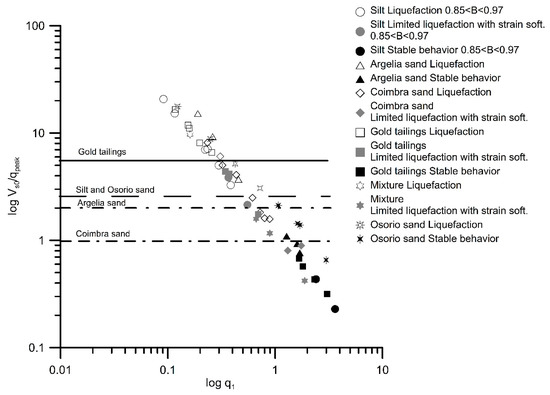
Figure 12.
Correlation between the normalized peak undrained deviatoric stress and the ratio between shear wave velocity and peak undrained deviatoric stress.

Table 9.
Vs0/qpeak ratios for true liquefaction triggering for the different tested materials.
Figure 13 shows that stability increases both with increasing shear wave velocity, Vs0, (or stiffness) and with increasing peak undrained deviatoric stress, qpeak, for all soils. Thus, stability increases with both increasing Vs1 and q1, reflecting greater contact between grains, due to the dual effect of the increase in confining pressure and the decrease in the void ratio.
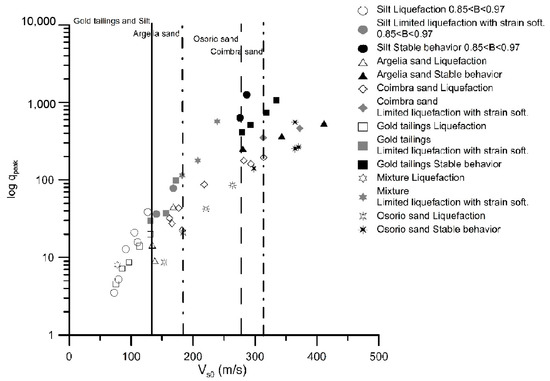
Figure 13.
Peak undrained deviatoric stress as a function of the shear wave velocity.
From both Figure 12 and Figure 13, further conclusions can be drawn. For instance, Figure 12 indicates that among the three sands, Algeria sand is the most stable one since the Vs0 boundary separating liquefaction from a stable behavior is obtained for low Vs0. This is believed to be associated with the greater roundness of its particles. On the contrary, Coimbra sand is the soil with higher brittleness due to its highly meta-stable structure created by the small contact bridges between its angular grains. It can also be observed that both Coimbra sand and the mixture can only reach full stability (i.e., a strain hardening behavior) for very high initial confining stresses (and/or low void ratios), as stability was not verified within the wide range of confining pressures applied during the triaxial tests (Table 7). Finally, both the gold tailings and the silt are the least prone to liquefaction, yet this was not reflected in a higher stability, since these soils display a strain softening behavior within a wide range of shear wave velocities.
Despite the robust correlations obtained with the laboratory results, good reasoning must be applied since a strong statistical correlation exists between both variables (i.e., between Vs0/qpeak and q1). In fact, a higher relevance should be given to the limiting effects of Vs0/qpeak when distinguishing liquefiable and non-liquefiable conditions than the correlation between Vs0/qpeak and q1, particularly under laboratory conditions.
Making use of the same parameters, a different approach may be adopted. This framework derives from a concept based on the simplified procedure proposed by [46], initially adopted for cyclic conditions [47], as shown in Figure 14. In this case study, instead of the cyclic resistance ratio (CRR), the normalized peak undrained deviatoric stress under monotonic conditions, qpeak/(2σ′h), is taken (Equation (4)). Although this chart was initially proposed for determining the cyclic resistance of sands with low fines content, an analogy can be made to identifying the boundary that separates liquefiable from non-liquefiable conditions. It should also be pointed out that Andrus and Stokoe’s equation was not corrected for fines content, instead it was decided to adjust both the b and Vs1* parameters. The main disadvantage of this framework is the existence of distinct boundaries, specific to each soil, which in this case, are a function of b and Vs1*. Table 10 summarizes these values for the studied soils, where it becomes clear that b is around 3.0 but Vs1* varies between 150 and 240 depending on the soil type. This is also observed in Figure 14 where the lines have approximately the same shape but their vertical asymptotes move to the right with increasing instability potential.
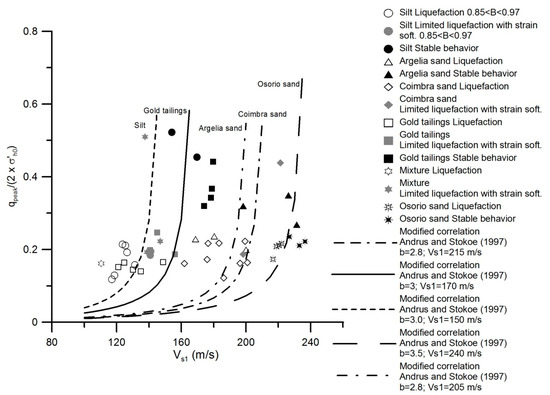
Figure 14.
Normalized peak deviatoric stress versus normalized shear wave velocity—simplified procedure to evaluate static liquefaction [46].

Table 10.
Vs1* and b fitting values for Equation (4).
In order to overcome the dispersion of the limiting ratios, given by VS0/qpeak, with the type of soil, a new framework is proposed.
4.4. Effect of Soil Type
It is known that soil liquefaction is mainly a function of the contractiveness of the soil, which is affected, in the first place, by relative density. Relative density, in turn, is affected by the grain size distribution, shape of the grains and specific gravity. For this case study, specific gravity was not an issue since most soils have similar values, except the gold tailings, which have a very distinct Gs value of 2.94. The challenge was to find a parameter that could take into account not only grain size distribution but also indirectly consider the shape of the grains. Ref. [48] studied the effect of soil grading on the undrained shear strength of sands, considering CU as an effective parameter to control shear resistance only for pure sand samples. Instead, the aim of this research was to define a single parameter for any soil type. Following this study, the coefficient of uniformity (CU) was found to be the most suitable parameter to correlate with the proposed ratios, as shown in Figure 15. Despite not being directly related to particle shape, CU can evaluate soil dispersion by considering particle diameter, which is highly related to potential fabric configuration. Following these studies, this research found the coefficient of uniformity to be a reliable measure of the liquefaction potential. Figure 15 illustrates the new approach for predicting soil liquefaction potential for any type of soil, using CU as a soil identifier.
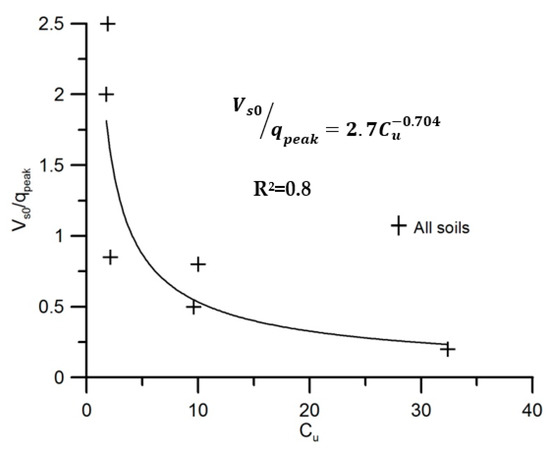
Figure 15.
Correlation between the coefficient of uniformity (CU) and the ratio of shear wave velocity to peak deviatoric stress (Vs0/qpeak) defining the limiting boundary between strain softening and strain hardening behavior.
In order to construct the graph in Figure 15, the correlations needed to be consistent for all the soils. For that, the adopted limiting Vs0/qpeak ratios were those between strain softening and strain hardening for finer soils (gold tailings, silt and mixture) and between true liquefaction and strain hardening for uniformly graded sands (Osorio sand, Argelia sand and Coimbra sand) since they typically do not exhibit strain softening, as summarized in Table 8. For the case of the mixture, the ratios provided were considered indicative due to the limited VS measurements in the undrained compression triaxial tests carried out so far.
Still, as with most correlations, this framework does have a limitation. According to this approach, soils with a better grading are likely to be more resistant to soil liquefaction. However, in the case of gap-graded specimens, which display a high CU (similar to well-graded soils), the Vs0/qpeak ratio would be expected to be high due to the high liquefaction potential (e.g., [49]). This would go against the trend displayed in Figure 15. In any case, natural soils are generally not gap-graded.
Although more data are needed to confirm this trend, these promising results suggest that the limiting boundary between liquefaction or strain softening and strain hardening defined in terms of the Vs0/qpeak ratio can be related grain size measured by the uniformity coefficient.
5. Conclusions
The results obtained from this laboratorial research expand the liquefaction assessment framework proposed by [19]. From this research, the ratio between the normalized shear wave velocity and the peak strength, Vs0/qpeak, proved to be a very good and reliable parameter for soil liquefaction assessment in different types of soils. The association between properties relative to both small and large strain levels, which are controlled (although differently) by the void ratio, mean stress state, contractiveness and soil structure, results in different functions of the same variables. Hence, these two measurements, as a ratio, can be useful in predicting not only liquefaction but also other relevant soil properties such as compressibility or cementation.
The boundary between strain hardening and strain softening soil behaviors measured by the Vs0/qpeak ratio was found to be a function of the coefficient of uniformity, CU. The correlation obtained between both parameters provided a reliable framework, independent of soil type, for the assessment of static soil liquefaction.
Further investigations involving distinct stress paths and distinct K0 consolidation conditions, among other factors, are necessary to evaluate if the observed correlation between Vs0/qpeak and CU is limited to specific conditions.
However, in the authors’ opinion, the potential of this framework goes beyond laboratory assessment and can also be applied to in situ data, namely via the seismic piezocone, by using a similar stiffness/stress ratio, known as the rigidity index, G0/qc. Therefore, this can be an important tool to assess the liquefaction potential of in situ soils, including natural deposits or mine tailings, contributing to safer and sustainable geotechnical structures.
Author Contributions
Conceptualization, Resources, A.V.d.F.; Investigation and writing, M.S.; Review & editing, C.F. and S.R.; Supervision, A.V.d.F. All authors have read and agreed to the published version of the manuscript.
Funding
The support of the Portuguese Foundation for Science and Technology (FCT) is also acknowledged through grant SFRH/BPD/120470/2016. This work was also financially supported by base funding—UIDB/04708/2020 of the CONSTRUCT—Instituto de I&D em Estruturas e Construções, funded by national funds through FCT/MCTES (PIDDAC).
Institutional Review Board Statement
Not applicable.
Informed Consent Statement
Not applicable.
Data Availability Statement
Data not available.
Acknowledgments
The authors would like to thank Fernando Schnaid for his cooperation during this research.
Conflicts of Interest
The authors declare no conflict of interest.
Nomenclature
| CC | coefficient of shape CU |
| CIU | isotopically consolidated undrained triaxial test |
| CRR | cyclic resistance ratio |
| CSL | critical state line |
| CU | coefficient of uniformity |
| CVR | critical void ratio line |
| emax | maximum void ratio |
| emin | minimum void ratio |
| G0 | small-strain shear modulus (MPa) |
| Gs | specific gravity |
| IB | brittleness index |
| IL | instability line |
| at rest coefficient of Earth’s pressure | |
| atmospheric pressure (approximately 100 kPa) | |
| qc | CPT tip cone resistance (MPa) |
| qpeak | peak undrained deviatoric stress (kPa) |
| SSL | steady state line |
| VS0 | shear wave velocity prior to shear stage (m/s) |
| VS0/qpeak | ratio between the shear wave velocity (VS0) and the peak undrained deviatoric stress |
| VS1 | normalized small-strain shear wave velocity (m/s) |
| σ′d(min) | minimum shear strength (kPa) |
| σ′d(peak) | peak shear strength (kPa) |
| mean effective confining pressure (kPa) | |
| vertical effective stress (kPa) | |
| ψ | state parameter, measured with reference to the CSL |
| state parameter, measured with reference to the SSL |
References
- Morgenstern, N.R.; Vick, S.G.; Viotti, C.B.; Watts, B.D. Fundão Tailings Dam Review Panel: Report on the Immediate Causes of the Failure of Fundao dam. 2015. Available online: https://pedlowski.files.wordpress.com/2016/08/fundao-finalreport.pdf (accessed on 29 September 2021).
- Jefferies, M.; Morgenstern, N.R.; Van Zyl, D.V.; Wates, J. Report on NTSF Embankment Failure; Technical Report; Valley Operations for Ashurst Operations: South Orange, NSW, Australia, 2019; Available online: https://www.newcrest.com/sites/default/files/2019-10/190417_Report%20on%20NTSF%20Embankment%20Failure%20at%20Cadia%20for%20Ashurst.pdf (accessed on 21 July 2023).
- Arroyo, M.; Gens, A. Computational Analyses of Dam I Failure at the Corrego de Feijao Mine in Brumadinho. Final Report from CIMNE to Vale S.A. 2021. Available online: http://www.mpf.mp.br/mg/sala-de-imprensa/noticias-mg/desastre-da-vale-relatorio-elaborado-por-universidade-da-espanha-aponta-causas-do-rompimento-da-barragem-em-brumadinho-mg (accessed on 21 July 2023).
- Casagrande, A. Characteristics of cohesionless soils affecting the stability of slopes and earth fills. J. Boston Soc. Civ. Eng. 1936, 23, 13–32. [Google Scholar]
- Been, K.; Jefferies, M.G. A state parameter for sands. Géotechnique 1985, 35, 99–112. [Google Scholar] [CrossRef]
- Uthayakumar, M.; Vaid, Y. Static liquefaction of sands under multiaxial loading. Can. Geotech. J. 1998, 35, 273–283. [Google Scholar] [CrossRef]
- Jefferies, M.G.; Been, K. Soil liquefaction. In A Critical State Approach; Taylor & Francis: Oxfordshire, UK, 2006. [Google Scholar]
- Sadrekarimi, A.; Olsen, S. Yield strength ratios, critical strength ratios and brittleness of sandy soils from laboratory tests. Can. Geotech. J. 2011, 48, 493–510. [Google Scholar] [CrossRef]
- Hird, C.C.; Hassona, F.A.K. Some factors affecting the liquefaction and flow of saturated sands in laboratory tests. Eng. Geol. 1990, 28, 149–170. [Google Scholar] [CrossRef]
- Stokoe, K.H.I.; Roesset, J.M.; Bierschwale, J.G.; Aouad, M. Liquefaction potential of sands from shear wave velocity. In Proceedings of the 9th World Conference on Earthquake Engineering, Tokyo, Japan, 2–9 August 1988; Volume 3, pp. 213–218. [Google Scholar]
- Tokimatsu, K.; Kuwayama, S.; Tamura, S. Liquefaction potential evaluation based on Rayleigh wave investigation and its comparison with field behavior. In Proceedings of the 2nd International Conference on Recent Advances in Geotechnical Earthquake Engineering and Soil Dynamics, St. Louis, MI, USA, 14 March 1991; Volume 1, pp. 357–364. [Google Scholar]
- Eslaamizaad, S.; Robertson, P.K. Evaluation of settlement of footings on sand from seismic in-situ tests. In Proceedings of the 50th Canadian Geotechnical Conference, Ottawa, ON, Canada, 20–22 October 1997; BiTech Publishers: Richmond, BC, Canada; Volume 2, pp. 755–764. [Google Scholar]
- Schnaid, F. Geocharacterization and engineering properties of natural soils by in situ tests. In Proceedings of the 16th International Conference on Soil Mechanics and Geotechnical Engineering, Osaka, Japan, 12–15 September 2005; Volume 1, pp. 3–45. [Google Scholar]
- Schnaid, F.; Yu, H.S. Theoretical interpretation of the seismic cone test in granular soils. Géotechnique 2007, 57, 265–272. [Google Scholar] [CrossRef]
- Schneider, J.A.; Moss, R.E.S. Linking cyclic stress and cyclic strain based methods for assessment of cyclic liquefaction triggering in sands. Géotechnique Lett. 2011, 1, 31–36. [Google Scholar] [CrossRef]
- Hardin, B.O. The nature of stress-strain behavior of soils. In Proceedings of the Earthquake Engineering and Soil Dynamics Conference (ASCE), Pasadena, CA, USA, 19–21 June 1978; Volume 1, pp. 3–90. [Google Scholar]
- Lo Presti, D.C.; Shibuya, S.; Rix, G.J. Innovation in soil testing. In Proceedings of the 2nd International Conference on Pre-Failure Deformation Characteristics of Geomaterials (IS Torino 99), Rotterdam, The Netherlands, 28–30 September 1999; Jamiolkowski, M., Lancellota, R., Lo Presti, D.C.F., Eds.; Volume 2, pp. 1027–1076. [Google Scholar]
- Viana da Fonseca, A.; Coop, M.R.; Fahey, M.; Consoli, N. The interpretation of conventional and non-conventional laboratory tests for challenging geotechnical problem. In Deformation Characteristics of Geomaterials; IOS Press: Amsterdam, The Netherlands, 2011; Volume 1, pp. 84–119. [Google Scholar]
- Schnaid, F.; Bedin, J.; Viana da Fonseca, A.; Costa-Filho, L.d.M. Stiffness and strength governing the static liquefaction of tailings. J. Geotech. Geoenviron. Eng. 2013, 139, 2136–2144. [Google Scholar] [CrossRef]
- Riveros, G.A.; Sadrekarimi, A. Static liquefaction behaviour of gold mine tailings. Can. Geotech. J. 2021, 58, 889–901. [Google Scholar] [CrossRef]
- Yang, Z.; Liu, X.; Guo, L.; Cui, Y.; Liu, T.; Shi, W.; Ling, X. Effect of silt/clay content on shear wave velocity in the Yellow River Delta (China), based on the cone penetration test (CPT). Bull. Eng. Geol. Environ. 2022, 81, 28. [Google Scholar] [CrossRef]
- Doygun, O.; Brandes, H.G.; Roy, T.T. Effect of Gradation and Non-plastic Fines on Monotonic and Cyclic Simple Shear Strength of Silica Sand. Geotech. Geol. Eng. 2019, 37, 3221–3240. [Google Scholar] [CrossRef]
- Zhao, J.; Zhu, Z.; Liu, J.; Zhong, H. Damping Ratio of Sand Containing Fine Particles in Cyclic Triaxial Liquefaction Tests. Appl. Sci. 2023, 13, 4833. [Google Scholar] [CrossRef]
- Santamarina, J.C.; Cho, G.C. Soil behaviour: The role of particle shape. In Proceedings of the Skempton Conference, Advances in Geotechnical Engineering: The Skempton Conference, London, UK, 29–31 March 2004; pp. 604–617. [Google Scholar]
- Cho, G.; Dodds, J.; Santamarina, J.C. Particle shape effects on packing density, stiffness, and strength: Natural and crushed sands. J. Geotech. Geoenviron. Eng. 2006, 132, 591–602. [Google Scholar] [CrossRef]
- Consoli, N.C.; Heineck, K.S.; Coop, M.R.; Viana da Fonseca, A.; Ferreira, C. Coal bottom ash as a geomaterial: Influence of particle morphology on the behavior of granular materials. Soils Found. 2007, 47, 361–373. [Google Scholar] [CrossRef]
- Consoli, N.; Viana da Fonseca, A.; Cruz, R.C.; Heineck, K.S. Fundamental parameters for the stiffness and strength control of artificially cemented sand. J. Geotech. Geoenvironmental Eng. 2009, 135, 1347–1353. [Google Scholar] [CrossRef]
- Santos, J.A.; Gomes, R.C.; Lourenço, J.C.; Marques, F.; Coelho, P.; Azeiteiro, R.; Santos, L.A.; Marques, V.; Viana da Fonseca, A.; Soares, M.; et al. Coimbra sand round robin tests to evaluate liquefaction resistance. In Proceedings of the 15th World Conference on Earthquake Engineering, Lisboa, Portugal, 24–28 September 2012. [Google Scholar]
- Viana da Fonseca, A.; Rocha, A.; Tahar, G. Liquefaction assessment charts on state and waves’ velocities from static and cyclic triaxial tests on “Les Dunes” sands from Algier. In Proceedings of the 5th International Conference on Earthquake Geotechnical Engineering, Santiago, Chile, 10–13 January 2011. [Google Scholar]
- Viana da Fonseca, A.; Soares, M. Effect of principal stress rotation on cyclic liquefaction. In Proceedings of the 2nd International Conference on Performance-Based Design in Earthquake Geotechnical Engineering, Taormina, Italy, 28–30 May 2012; pp. 441–454. [Google Scholar]
- Viana da Fonseca, A.; Soares, M. Critical state soil mechanics assessment of instability and liquefaction locus of a sandy soil from Coimbra. In Proceedings of the XVII Brasilian Conference on Soil Mechanics and Geotechnical Engineering, Goiânia, Brasil, 9–13 September 2014. [Google Scholar]
- ASTM D4254; Standard Test Methods for Minimum Index Density and Unit Weight of Soils and Calculation of Relative Density. American Society of Testing Materials: West Conshohocken, PA, USA, 2016.
- ASTM D2487; Standard Practice for Classification of Soils for Engineering Purposes (Unified Soil Classification System). American Society of Testing Materials: West Conshohocken, PA, USA, 2017.
- Soares, M. Evaluation of Soil Liquefaction Potential Based on Laboratory Data. Major Factors and Limit Boundaries. Ph.D. Thesis, University of Porto, Porto, Portugal, 2014. [Google Scholar]
- Bedin, J. Study of the Geomechanical Behavior of Tailings. Ph.D. Thesis, Federal University of Rio Grande do Sul, Porto Alegre, Brazil, 2010. [Google Scholar]
- Viana da Fonseca, A.V.; Cordeiro, D.; Molina-Gómez, F. Recommended procedures to assess critical state locus from triaxial tests in cohesionless remoulded samples. Geotechnics 2021, 1, 95–127. [Google Scholar] [CrossRef]
- Soares, M.; Viana da Fonseca, A. Factors affecting steady state locus in triaxial tests. Geotech. Test. J. 2016, 39, 1056–1078. [Google Scholar] [CrossRef]
- Viana da Fonseca, A.; Ferreira, C.; Fahey, M. A framework interpreting bender element tests, combining time-domain and frequency-domain methods. ASTM Geotech. Test. J. 2009, 32, 91–107. [Google Scholar] [CrossRef]
- Nicholson, P.G.; Seed, R.B.; Anwar, H.A. Elimination of membrane compliance in undrained triaxial testing. I. Measurement and evaluation. Can. Geotech. J. 1993, 30, 727–738. [Google Scholar] [CrossRef]
- CEN. Standard on Geotechnical Investigation and Testing—Laboratory Testing of Soil—Part 9: Consolidated Triaxial Compression on Water Saturated Soil; Technical Report; Comité Européen de Normalisation: Brussels, Belgium, 2004. [Google Scholar]
- Bedin, J.; Schnaid, F.; Viana da Fonseca, A. Gold tailings liquefaction using critical state soil mechanics concepts. Géotechnique 2012, 62, 263–267. [Google Scholar] [CrossRef]
- Lade, P.V. Instability, shear banding, and failure in granular materials. Int. J. Solids Struct. 2002, 39, 3337–3357. [Google Scholar] [CrossRef]
- Lade, P.V.; Yamamuro, J.A. Stability of granular materials in post peak softening regime. J. Eng. Mech. 1993, 119, 128–144. [Google Scholar] [CrossRef]
- Lade, P.V.; Yamamuro, J.A. Effects of nonplastic fines on static liquefaction of sands. Can. Geotech. J. 1997, 34, 918–928. [Google Scholar] [CrossRef]
- Chu, J.; Leong, W.K.; Loke, W.L.; Wanatowski, D. Instability of loose sand under drained conditions. J. Geotech. Geoenvironmental Eng. 2012, 138, 207–216. [Google Scholar] [CrossRef]
- Andrus, R.D.; Stokoe, K.H. Liquefaction Resistance Based on Shear Wave Velocity. In Proceedings of the National Center for Earthquake Engineering Research (NCEER) Workshop on Evaluation of Liquefaction Resistance of Soils, New York, NY, USA, 31 December 1997; Youd, T.Y., Idriss, I.M., Eds.; [Google Scholar]
- Soares, M.; Bedin, J.; Silva, J.; Viana da Fonseca, A. Monotonic and cyclic liquefaction assessment on silty soils by triaxial tests with bender elements. In Proceedings of the International Conference on Advances in Geotechnical Engineering, Perth, Australia, 7–9 November 2011. [Google Scholar]
- Bayat, E.; Bayat, M. Effect of grading characteristics on the undrained shear strength of sand: Review with new evidences. Arab. J. Geosci. 2013, 6, 4409–4418. [Google Scholar] [CrossRef]
- Igwe, O.; Fukuoka, H.; Sassa, K. The effect of relative density and confining stress on shear properties of sands with varying grading. Geotech. Geol. Eng. 2012, 30, 1207–1229. [Google Scholar] [CrossRef]
Disclaimer/Publisher’s Note: The statements, opinions and data contained in all publications are solely those of the individual author(s) and contributor(s) and not of MDPI and/or the editor(s). MDPI and/or the editor(s) disclaim responsibility for any injury to people or property resulting from any ideas, methods, instructions or products referred to in the content. |
© 2023 by the authors. Licensee MDPI, Basel, Switzerland. This article is an open access article distributed under the terms and conditions of the Creative Commons Attribution (CC BY) license (https://creativecommons.org/licenses/by/4.0/).